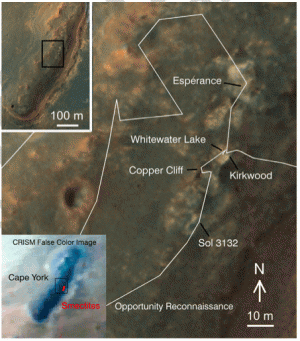
Matijevic Hill (black rectangle) on the Cape York rim segment of Endeavour Crater contains rocks both older and younger than the Endeavour impact. They point to a less acidic water environment than that which produced the overlying sulfate-rich Burns formation sandstones. (Image is Figure 1 from the paper.)
A new paper in Science from a team led by Raymond Arvidson (Washington University) and Steven Squyres (Cornell University) reports on water-related minerals found by the Mars Exploration Rover Opportunity, which reached Endeavour Crater in August 2011. The paper is part of a special section on Mars habitability in the issue and online commemorating the 10th anniversary of the MER landings.
Exploring the Cape York rim segment, and in particular Matijevic Hill, the rover team found evidence of water-rock interactions before and after the Noachian-era impact that made Endeavour. Aqueous environments ranged from slightly acidic to approximately neutral pH.
The team notes, “This would have been more favorable for prebiotic chemistry and microorganisms than those recorded by younger sulfate-rich rocks at Meridiani Planum.”








